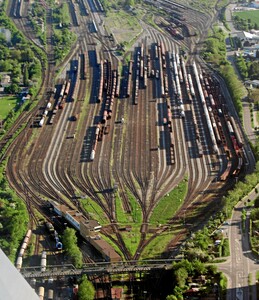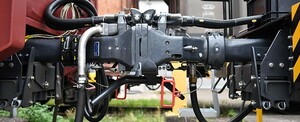 The transport sector in Europe accounts for around 20% of the Co 2 Responsible for emissions and thus one of the main causes of Co 2 Emissions. That is why a shift in freight transport to rail is the order of the day. And at the moment one has the impression that due to the global climate crisis Movement in rail freight transport comes. One of the important milestones in rail freight transport would be a digital automatic coupling (DAK). A simpler automatic coupling has been implemented in North American rail freight transport for decades.
The transport sector in Europe accounts for around 20% of the Co 2 Responsible for emissions and thus one of the main causes of Co 2 Emissions. That is why a shift in freight transport to rail is the order of the day. And at the moment one has the impression that due to the global climate crisis Movement in rail freight transport comes. One of the important milestones in rail freight transport would be a digital automatic coupling (DAK). A simpler automatic coupling has been implemented in North American rail freight transport for decades.
What does the automatic coupling do?
With the automatic, freight wagons are automatically connected to electricity, data and compressed air lines. This makes coupling faster and easier. Because domes are hardest manual work. For more than 100 years, wagons have been linked with heavy screw couplings. This process takes a long time, is hard work and can be very dangerous. Serious accidents happen again and again during this work. When coupling, the employee has to hang the heavy screw coupling between the wagons, tighten the connection and connect the brake lines by hand. In addition, this work often takes place at night. Railway companies also complain that they cannot find employees for the job.
How does the digital automatic coupling (DAK) work?
 There are different types of coupling. The DAK type 4 is to be used in Europe. This model combines an automatic coupling with the digitization of the freight railways.
There are different types of coupling. The DAK type 4 is to be used in Europe. This model combines an automatic coupling with the digitization of the freight railways.
When coupling, brake lines and additional power and data lines are automatically connected. This should then make it possible to install and use sensors on the individual cars that communicate with the towing vehicle.
Dangers of the current system
It is currently the case that the train driver in the towing vehicle has no idea what is going on with the attached freight wagons. It sometimes happens that a wagon of a train derails and the engine driver sometimes only notices after 1,000 meters that something is wrong. By then, the derailed wagon could have caused several million euros in damage to the infrastructure. There is simply no communication between the wagon and the locomotive, and the large mass of the train does not immediately make the derailment of individual wagons obvious. If the train had installed sensors that would indicate such a derailment, major damage could be prevented. The DAK would have already integrated such systems.
Advantages of the digital automatic coupling
The digital automatic coupling has many advantages:
- Trains with a length of more than 1000 m and a train weight of 5000 tons are possible (currently 740 meters and a maximum of 2,100 tons are possible)
- Monitoring of freight wagons while they are in motion
- Automatic release and coupling of wagons
- Saving of personnel expenses (shifters)
- Coping with the necessary larger capacities in freight transport
- More effective, faster, more cost-effective handling of freight transport services
The possible cost savings are shown in the following figure:


Implementation costs and timeframe:
- It is necessary to convert around 490,000 freight cars and 17,000 locomotives
- The conversion per car costs between 15,000 and 17,000 euros
- Experts put the total costs for Europe at around EUR 8.6 billion
- The time horizon for the renovation is set to 2030
Our conclusion
The time is more than ripe for this technological leap in rail freight transport. If we want to achieve climate targets and transport in a more environmentally friendly way, we need innovations and investments in railways. The DAK is an important piece of the puzzle.
Additional information
- “Automatic coupling” project for rail freight transport in Europe at DB at a glance: https://youtu.be/gcAEfSRKc4Y
- A comparison of freight transport by rail versus road
Sources: DB, Allianz pro Schiene, Handelsblatt



